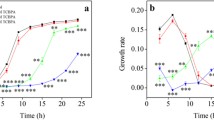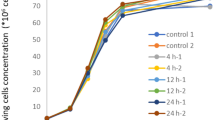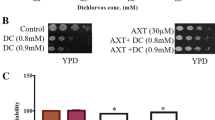Abstract
Hydroquinone (HQ) and benzoquinone (BQ) are known benzene metabolites that form reactive intermediates such as reactive oxygen species (ROS). This study attempts to understand the effect of benzene metabolites (HQ and BQ) on the antioxidant status, cell morphology, ROS levels and lipid alterations in the yeast Saccharomyces cerevisiae. There was a reduction in the growth pattern of wild-type cells exposed to HQ/BQ. Exposure of yeast cells to benzene metabolites increased the activity of the anti-oxidant enzymes catalase, superoxide dismutase and glutathione peroxidase but lead to a decrease in ascorbic acid and reduced glutathione. Increased triglyceride level and decreased phospholipid levels were observed with exposure to HQ and BQ. These results suggest that the enzymatic antioxidants were increased and are involved in the protection against macromolecular damage during oxidative stress; presumptively, these enzymes are essential for scavenging the pro-oxidant effects of benzene metabolites.









Similar content being viewed by others
References
Akerboom TP, Sies H (1981) Assay of glutathione, glutathione disulfide, and glutathione mixed disulfides in biological samples. Methods Enzymol 77:373–382
Aksoy M (1989) Hematotoxicity and carcinogenicity of benzene. Environ Health Perspect 82:193–197
Arthur JR (2000) The glutathione peroxidases. Cell Mol Life Sci 57:1825–1835
Aust SD (1994) Thiobarbituric acid assay reactants. Methods Toxicol 1B:367–374
Avery AM, Avery SV (2001) Saccharomyces cerevisiae expresses three phospholipid hydroperoxide glutathione peroxidases. J Biol Chem 276:33730–33735
Beauchamp C, Fridovich I (1971) Superoxide dismutase: improved assays and an assay applicable to acrylamide gels. Anal Biochem Rev 44:276–287
Bell RM, Coleman RA (1980) Enzymes of glycerolipid synthesis in eukaryotes. Annu Rev Biochem 49:459–487
Bligh EG, Dyer WJ (1959) A rapid method for total lipid extraction and purification. Can J Biochem Physiol 37:911–917
Bose S, Sinha SP (1994) Modulation of ochratoxin-produced genotoxicity in mice by vitamin C. Food Chem Toxicol 32:533–537
Bradford MM (1976) A rapid and sensitive method for the quantitation of microgram quantities of protein utilizing the principle of protein-dye binding. Anal Biochem 72:248–254
Carman GM, Zeimetz GM (1996) Regulation of phospholipid biosynthesis in the yeast Saccharomyces cerevisiae. Biol Chem 271:13293–13296
Chattopadhyay MK, Raghu G, Sharma YVRK, Biju AR, Rajasekharan MV, Shivaji (2011) Increase in oxidative stress at low temperature in an antarctic bacterium. Curr Microbiol 62:544–546
Chelikani P, Fita I, Loewen PC (2004) Diversity of structures and properties among catalases. Cell Mol Life Sci 61(2):192–208
Davies KJA (1995) Oxidative stress: the paradox of life. Biochem Soc Symp 61:1–31
Dickinson DA, Forman HJ (2002) Cellular glutathione and thiols metabolism. Biochem Pharmacol 64:1019–1026
Dix TA, Aikens J (1993) Mechanisms and biological relevance of lipid peroxidation initiation. Chem Res Toxicol 6:2–18
Driver AS, Kodavanti PS, Mundy WR (2000) Age-related changes in reactive oxygen species production in rat brain homogenates. Neurotoxicol Teratol 22(2):175–181
Golding BT, Barnes ML, Bleasdale C, Henderson AP, Jiang D, Li X (2010) Modeling the formation and reactions of benzene metabolites. Chem Biol Interact 184:196–200
Hapala I, Marza E, Ferreira T (2011) Is fat so bad? Modulation of endoplasmic reticulum stress by lipid droplet formation. Biol Cell 103:271–285
IARC (1977) IARC Monographs on the evaluation of the carcinogenic risk of chemicals to man, vol 15, Some Fumigants, the Herbicides 2,4-d and 2,4,5-T, Chlorinated dibenzodioxins and Miscellaneous Industrial Chemicals, Lyon, p 255–264
Jeltsch A (2002) Beyond Watson and Crick: DNA methylation and molecular enzymology of DNA methyltransferases. ChemBioChem 35:382–382
Kataoka M, Fukura Y, Shinohara Y, Baba Y (2005) Analysis of mitochondrial membrane potential in the cells by microchip flow cytometry. Electrophoresis 26(15):3025–3031
Kohlwein SD, Veenhuis M, van der Klei IJ (2013) Lipid droplets and peroxisomes: key players in cellular lipid homeostasis or a matter of fat–store ‘em up or burn ‘em down. Genetics 193:1–50
Lesuisse E, Labbe P (1995) Effects of cadmium and of YAP1 and CAD1/YAP2 genes on iron metabolism in the yeast Saccharomyces cerevisiae. Microbiology 141:2937–2943
Lin CL, Chen HJ, Hou WC (2002) Activity staining of glutathione peroxidase after electrophoresis on native and sodium dodecyl sulfate polyacrylamide gels. Electrophoresis 23:513–516
Lingnert H, Goran A, Caj EE (1989) Antioxidative effect of superoxide dismutase from Saccharomyces cerevisiae in model systems. J Agric Food Chem 37:23–28
Maiorino M, Gregolin C, Ursini F (1990) Phospholipid hydroperoxide glutathione peroxidase. Methods Enzymol 186:448–457
Marklund S, Marklund G (1974) Involvement of the superoxide anion radical in the autoxidation of pyrogallol and a convenient assay for superoxide dismutase. Eur J Biochem 47(3):469–474
Marnett LJ (1999) Lipid peroxidation: DNA damage by malondialdehyde. Mutat Res 424:83–95
Monks TJ, Hanzlik RP, Cohen GM, Ross D, Graham DG (1992) Contemporary issues in toxicology: quinone chemistry and toxicity. Toxicol Appl Pharmacol 112:2–16
Muthukumar K, Rajakumar S, Sarkar MN, Nachiappan V (2011) Glutathione peroxidase3 of Saccharomyces cerevisiae protects phospholipids during cadmium-induced oxidative stress. Antonie Van Leeuwenhoek 99:761–771
O’Brien PJ (1991) Molecular mechanisms of quinone cytotoxicity. Chem-Biol Interact 80:1–14
Omaye ST, Turnbull JD, Sauberlich HE (1979) Selected methods for the determination of ascorbic acid in animal cells, tissues and fluids. Methods Enzymol 62:3–11
Padh H (1991) Vitamin C: newer insights into its biochemical functions. Nutr Rev 49:65–70
Rajakumar S, Ravi C, Nachiappan V (2016) Defect of zinc transporter ZRT1 ameliorates cadmium induced lipid accumulation in Saccharomyces cerevisiae. Metallomics. doi:10.1039/C6MT00005C
Rouser G, Fleischer S, Yamamoto A (1970) Two dimensional thin layer chromatographic separation of polar lipids and determination of phospholipids by phosphorous analysis of spots. Lipids 5:494–496
Senaratna T, Mackay CE, Mckersie BD, Fletcher RA (1988) Uniconazol induced chilling tolerancein tomato and its relationship to antioxidant content. J Plant Physiol 133:55–61
Shen HM, Shi CY, Lee HP, Ong CN (1994) Aflatoxin Br induced lipid peroxidation in rat liver. Toxicol Appl Pharmacol 127:145–150
Sinha AK (1972) Colorimetric assay of catalase. Anal Biochem 47:389–394
Snyder R, Hedli CC (1996) An overview of benzene metabolism. Environ Health Perspect 104(Suppl. 6):1165–1171
Srinivasan P, Sabitha KE, Shyamaladevi CS (2007) Attenuation of 4-nitroquinoline 1-oxide induced in vitro lipid peroxidation by green tea polyphenols. Life Sci 80:1080–1086
Steels EL, Learmonth RP, Watson K (1994) Stress tolerance and membrane lipid unsaturation in Saccharomyces cerevisiae grown aerobically or anaerobically. Microbiology 140(Pt 3):569–576
Steffesen IL, Mesna OJ, Andruchow E, Namork E, Hylland K, Andersen RA (1994) Cytotoxicity and accumulation of Hg, Ag, Cd, Cu, Pb and Zn in human peripheral T and B lymphocytes and monocytes in Vitro. Gen. Pharmac 25:1621–1633
Stohs SJ, Bagchi D (1995) Oxidative mechanisms in the toxicity of metal ions. Free Rad Biol Med 18:321–336
Temple MD, Perrone GG, Dawes IW (2005) Complex cellular responses to reactive oxygen species. Trends Cell Biol 15:319–326
Treadwell FP, Hall WT (1948) Analytical chemistry, vol 2. Wiley, New York
Ursini F, Maiorino M, Brigelius-Flohe R, Aumann KD, Roveri A, Schomburg D, Flohe L (1995) Diversity of glutathione peroxidases. Methods Enzymol 252:38–53
Vertuani S, Angusti A, Manfredini S (2004) The antioxidants and pro-antioxidants network: an overview. Curr Pharm Des 10(14):1677–1694
Vijayaraj P, Sabarirajan J, Nachiappan V (2010) Enhanced phospholipase B activity and alteration of phospholipids and neutral lipids in Saccharomyces cerevisiae exposed to N-nitrosonornicotine. Antonie Van Leeuwenhoek 99:567–577
Wallace L (1996) Environmental exposure to benzene: an update. Environ Health Perspect 104(Suppl. 6):1129–1136
Wiemels J, Smith MT (1999) Enhancement of myeloid cell growth by benzene metabolites via the production of active oxygen species. Free Radic Res 30:93–103
Yamashita A, Sugiura T, Waku K (1997) Acyltransferases and transacylases involved in fatty acid remodeling of phospholipids and metabolism of bioactive lipids in mammalian cells. J Biochem 122:1–16
Zhang J, Jia W, Yang J, Ismail AM (2006) Role of ABA in integrating plant responses to drought and salt stresses. Field Crop Research 97:111–199
Acknowledgments
We thank the infrastructure facilities from the DST-FIST of Biochemistry Department, DST-PURSE and Life Sciences facilities of Bharathidasan University.
Author information
Authors and Affiliations
Corresponding author
Rights and permissions
About this article
Cite this article
Raj, A., Nachiappan, V. Exposure to benzene metabolites causes oxidative damage in Saccharomyces cerevisiae . Antonie van Leeuwenhoek 109, 841–854 (2016). https://doi.org/10.1007/s10482-016-0684-7
Received:
Accepted:
Published:
Issue Date:
DOI: https://doi.org/10.1007/s10482-016-0684-7




